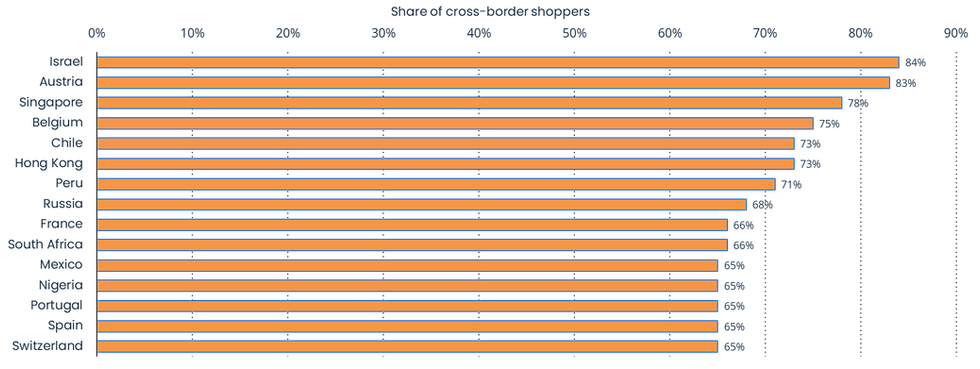Analysis of Target Markets
- Patricia Carvajal
- Jun 27, 2023
- 5 min read

By Patricia Carvajal
The purpose of this blog entry is to explore the world of target market analysis to provide e-commerce professionals with invaluable insights for optimizing their marketing efforts and expanding their brands to a global audience. By providing a clear and concise roadmap, we aim to empower businesses to make informed decisions and drive growth in the dynamic landscape of e-commerce, targeting their ideal customers.
Statistics show that there will be high growth in the b2c sector of e-commerce companies selling internationally. This sector will generate around $7 billion by 2030, highlighting the immense potential for businesses to reach a diverse audience.
Cross-border business-to-consumer (B2C) e-commerce market value worldwide in 2021 and 2030 (in billion U.S. dollars). Source: Statista

What is needed? Expanding an e-commerce business globally requires a deep understanding of the diverse and variable nature of each market, including the demographics of the target audience. By comprehending the behavior and preferences of potential consumers in each country through market research, businesses can develop a realistic and tailored strategy that addresses their specific needs and resonates with the ideal customer.
In this blog we will first explain what is important to analyse in the market research first with the size and segmentation, followed by the analysis of the behaviour of potential customers. We will then take look at how to analyse the competition and finally the legal aspects that need to be considered.
Starting with Market Size and Cultural Aspects: Market Selection: Carefully evaluate and select the target market that aligns best with your product/service and the preferences of your ideal audience. Consider factors like proximity, cultural affinity, and tax advantages, which can enhance market penetration and optimize business operations. Every market is different, and every country has customs and international trade offices that can guide you through the process of making international sales. There is literature available that can help you in case you want to take a global view, books like Grow your Global Markets by Raymond A. Hopkins, can help you have a first overview of the different regions. There’s also the chance to check online reports of the last trends for different countries, sites like Statista and Hootsuite offer this kind of insights.
Customized Internationalization Approach: Craft an internationalization process that caters to the specific needs and characteristics of each target market and segment, taking into account the demographics and preferences of the segment and audience. Ensuring a personalized customer experience is essential, including localized customer support, user-friendly interfaces in the local language, and accommodating local payment methods. By offering a seamless and localized experience, businesses can build trust, enhance customer satisfaction, and differentiate themselves from competitors. There’s a great meaning into knowing how are the channels of communication and also what are the social media platforms that are relevant for the target audience. May also vary by where users shop for international products, the graphic below shows that a good practice will be to have the own website completely optimize for the target market.
Here are global statistics on what would be the preferred platform types to buy branded products among cross-border online shoppers in 2022.
Preferred platform types to buy branded products among cross-border online shoppers in 2022. Source: Statista

Growth potential: Research the market's historical growth rate and projected future growth to gain insights into its sustainability and attractiveness to your ideal segment and customer. Assess the market's readiness for e-commerce by examining factors such as internet penetration, mobile usage, and digital adoption among the target demographic.
Some markets might have a target audience that is rather more willing to buy products from international companies. The following graph show some of the markets that have a percentage of cross-border online shoppers in selected countries worldwide in 2022
Percentage of cross-border online shoppers in selected countries worldwide in 2022. Source: Statista.

Now let´s take a look on consumer behavior of the target market:
Market Insights: Gain deep insights into the behavior of the "new potential customers" in the target market through market research. Understand unique promotional calendars, consumer preferences, market trends, and competitor landscape. This knowledge is vital for adapting your marketing efforts and e-commerce strategy to resonate with the local audience and gain a competitive edge.
The language and the type of content importance: Language plays a vital role in effective communication. Using the local language or translating content accurately helps convey messages clearly and avoids misunderstandings. It allows businesses to effectively communicate product features, benefits, and value propositions, ensuring the target market understands and appreciates the offering.
Cultural Sensitivity: Each culture has its own norms, values, and sensitivities. By understanding the cultural context, businesses can tailor their content to respect and align with the cultural expectations of the target market. This includes considering cultural taboos, symbols, humor, and imagery to avoid any inadvertent offense or misinterpretation. Creating personas profiles might help with this aspect.
Competitor Analysis:
Making an analysis of the competitor can help you understand what are the standards that your target audience is used to. Here are some key points to be considered:
Identify competitors: Start by identifying direct competitors in the target market that offer similar products or services and target the same customer base. Analyze and define how they market their offerings to the audience and how they engage with the ideal customer.
Analyze products and pricing: Evaluate your competitors' product offerings and pricing strategies to ensure your products are competitive and meet the needs of the target audience.
Review marketing strategies: Examine how competitors are promoting their products to the new audience. Analyze their social media presence, websites, marketing campaigns and advertising campaigns to identify relevant marketing channels and strategies.
Evaluate customer service: Research how competitors handle customer service in your new target market. Understand what your target audience expects by looking at what the competition is doing and aim to provide exceptional customer service that sets you apart.
Legal aspects:
When conducting market research, it is also important to consider the legal aspects: Legal Aspects and WTO: Thoroughly research the legal aspects that belong to your sector and international trade, considering the guidelines set by the World Trade Organization (WTO). Comprehending these regulations will ensure compliance and mitigate potential legal challenges. International Transaction Collection Methods: Understand the various methods used for collecting payments in international transactions, particularly as they relate to e-commerce websites. Negotiate and establish secure and efficient payment channels that cater to the needs of your international customers. Customs Laws and VAT Regulations: Be aware of customs laws and regulations governing international trade, including Value-Added Tax (VAT). Stay informed about exemptions for intra-Community supplies of goods and exports to optimize your e-commerce operations. Taxation Considerations: Gain a comprehensive understanding of the taxation requirements in the country you plan to expand your e-commerce website to. Familiarize yourself with the tax regulations of both your home country and the target market to ensure compliance and effectively manage your tax obligations.
After conducting this research, I believe it is crucial to approach all these aspects in an applied and thorough way. It is about finding and building the right keys to open the door to a new audience, so that the flow of business is active, unimpeded, and successful. It is the job of online marketers and e-commerce professionals to build those bridges between different places so that the exchange is dynamic and represents a seamless relationship in which the new audience embraces the brand as if it were from that society, country, or region. By understanding the marketing efforts needed, analyzing the audience and demographic, conducting market research, and focusing on the ideal customer, businesses can optimize their strategies and establish a strong presence in new markets.
Sources:
Hopkins, R. A. (2017). Grow Your Global Markets: A Handbook for Successful Market Entry. United States: Apress. Meidl, O. (2014).
Global Webshop: E-Commerce-Ansprüche am internationalen Markt. Germany: Springer Fachmedien Wiesbaden.




Commentaires